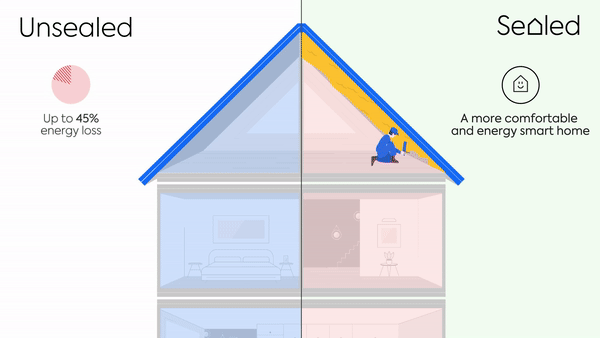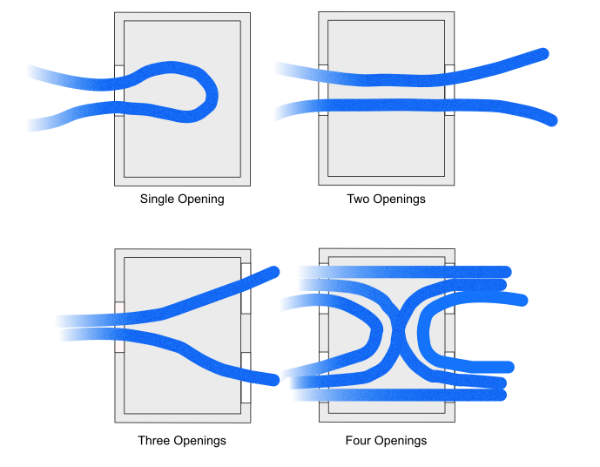Exploring Ingenious Solutions for Ideal Home Air Flow Equipments
Home air flow plays a vital role in keeping health and wellness and convenience within living areas. With advancements in technology, ingenious services are emerging to enhance these systems. Smart air flow, power recovery ventilators, and advanced filtering are reshaping how air quality is handled - Home Ventilation Melbourne. The integration of these innovations elevates questions concerning their efficiency and flexibility in varied home atmospheres. What implications do these developments hold for future living standards?
The Significance of Home Air Flow for Health And Wellness and Comfort
Commonly neglected, home air flow plays a crucial function in maintaining both health and comfort within household areas. Adequate air flow is vital for the flow of fresh air, which assists to thin down interior toxins such as unpredictable natural substances, allergens, and smells. Without appropriate air flow, these contaminants can gather, resulting in respiratory system concerns and other health troubles. Furthermore, effective air flow adds to controling humidity degrees, avoiding mold development and architectural damage. By making sure a balanced exchange of air, citizens can delight in a much more positive indoor setting, improving total health. In addition, appropriate air flow can enhance energy effectiveness by minimizing the need for extreme home heating or cooling, eventually causing reduced energy expenses and a more sustainable home.
Smart Air Flow Solutions: Harnessing Modern Technology for Effectiveness
Smart air flow systems represent a significant improvement in home air management, leveraging IoT combination for boosted control. These systems not only advertise power efficiency but also supply remote tracking capacities, enabling individuals to maximize their indoor atmospheres flawlessly. By using technology, home owners can achieve better air top quality while lowering energy consumption.
IoT Assimilation Benefits
How can IoT combination change typical air flow systems into very effective clever solutions? By integrating Web of Points (IoT) modern technology, air flow systems can achieve real-time tracking and control, improving their functional performance. Sensors put throughout a home collect information on air top quality, humidity, and temperature level, enabling for automated adjustments based on current conditions. This prompt responsiveness leads to enhanced interior air top quality and convenience degrees. In addition, IoT-enabled systems can communicate with other wise home tools, developing a cohesive ecosystem that enhances power usage. Users can additionally accessibility and manage their ventilation systems remotely via mobile phones, giving benefit and boosted control. In general, IoT combination represents a substantial advancement, bringing knowledge and versatility to traditional ventilation methods.
Energy Effectiveness Features
As power performance ends up being an essential focus in modern home style, progressed air flow systems provide innovative attributes that substantially minimize power intake. These smart ventilation systems make use of sensing units to keep track of interior air temperature level, high quality, and moisture degrees, immediately changing air flow to keep excellent conditions. By utilizing energy recuperation ventilators (ERVs), they capture and reuse energy from outgoing air, reducing heating and cooling down demands. Variable rate fans better improve efficiency by adjusting their operation based on real-time requirements, protecting against unnecessary energy waste - Home Ventilation Melbourne. Additionally, programmable timers and tenancy sensing units assure that air flow runs just when essential, adding to lower energy expenses. Jointly, these features represent a substantial development in developing energy-efficient and sustainable living settings
Remote Tracking Abilities
What advantages do remote surveillance capabilities offer modern-day home ventilation systems? These capacities enable property owners to track interior air high quality and system efficiency in actual time, boosting general efficiency. By giving data on moisture, air, and temperature pollutants, clever air flow systems enable positive modifications, making certain suitable problems. On top of that, remote tracking facilitates maintenance informs, determining potential concerns prior to they rise, thus reducing fixing expenses and downtime. Users can access system analytics through mobile applications, enabling for convenient control even when far from home. This technical assimilation not just advertises energy efficiency yet additionally contributes to a much healthier living setting. Eventually, remote monitoring abilities represent a significant improvement in home air flow, aligning with the growing need for wise home technologies.
Power Recovery Ventilators: Maximizing Energy Savings
Energy recuperation ventilators (ERVs) play an important duty in enhancing home energy efficiency through effective heat exchange. By transferring thermal energy between outgoing and inbound air, these systems considerably minimize overall power usage. This ingenious technique not only keeps interior air quality but likewise adds to lower utility prices.
Efficiency of Heat Exchange
While keeping interior air high quality is crucial for health and comfort, the performance of warm exchange in power recuperation ventilators (ERVs) plays an important role in optimizing power cost savings. The primary function of an ERV is to move warmth and wetness between outgoing and incoming air streams, which enhances indoor problems while lessening power loss. High-efficiency heat exchangers can significantly minimize the lots on home heating and cooling systems by redeeming power that would certainly otherwise be wasted. The effectiveness of these systems is commonly determined by their core temperature exchange prices, which can vary based on design and products made use of. By concentrating on sophisticated warmth exchange technologies, house owners can improve their ventilation systems, causing enhanced energy effectiveness and expense reductions over time.
Decreased Power Usage
Lowering power consumption is a key benefit of power recuperation ventilators (ERVs), as they effectively reuse thermal energy from worn down air. By moving heat between outward bound and incoming jet stream, ERVs lessen the requirement for extra home heating or cooling, leading to significant power financial savings. This process not just reduces energy expenses yet also decreases the ecological influence associated with greater energy usage. Additionally, ERVs preserve constant interior air quality without endangering thermal comfort, developing a well balanced living atmosphere. By incorporating ERVs right into home air flow systems, home owners can achieve greater power performance, enabling a sustainable method to interior air administration while taking advantage of lower power expenses. Eventually, ERVs represent a compelling service for energy-conscious customers.
Advanced Filtration Technologies for Cleaner Indoor Air
As indoor air high quality comes to be progressively acknowledged as an essential element of health and well-being, advanced filtration technologies are emerging as crucial devices for making sure cleaner environments. These innovations include high-efficiency particle air (HEPA) filters, activated carbon filters, and electrostatic precipitators, each designed to successfully catch air-borne pollutants, allergens, and volatile organic compounds (VOCs) HEPA filters can catch particles as tiny as 0.3 microns, greatly lowering irritants like allergen and pet dander. Turned on carbon filters succeed in adsorbing odors and chemical vapors, adding to a fresher interior ambience. In addition, electrostatic precipitators utilize electric charges to remove bits, providing an energy-efficient choice. By incorporating these innovative filtration systems, homeowners can improve interior air top quality and advertise healthier home.
The Role of Sensors in Maximizing Air Movement and High Quality
How can sensors transform the management of indoor air high quality? Sensors play an important duty in enhancing air flow and enhancing interior settings. By continuously monitoring variables such as humidity, temperature level, and levels of pollutants, they offer real-time data that educates air flow systems. This information makes it possible for automatic adjustments to airflow, making sure appropriate flow and minimizing the build-up of impurities. Additionally, advanced sensing units can find specific air top quality problems, prompting prompt actions to improve convenience and health and wellness. The combination of these devices right into air flow systems enables for a much more receptive and efficient monitoring strategy, minimizing power intake while maintaining suitable air top quality. Inevitably, sensors serve as a vital component in developing much healthier indoor spaces with specific you can check here air flow law.
Incorporating Ventilation With Smart Home Equipments
While many property owners look for benefit and efficiency, integrating air flow systems with clever home modern technology offers an ingenious service to handling interior air quality. By attaching ventilation devices to clever home centers, residents can automate air top quality surveillance and control air flow based upon real-time data. These systems can reply to changes in moisture, contaminant, and temperature levels, ensuring ideal interior problems. Smart thermostats can function in tandem with air flow systems to enhance power efficiency, decreasing prices while preserving comfort. Property owners can also from another location manage their ventilation settings through mobile applications, offering adaptability and satisfaction. Eventually, this assimilation not only simplifies monitoring however greatly boosts the general living setting, making it a valuable addition to contemporary homes.
Future Patterns in Home Air Flow Solutions
Emerging innovations and heightened recognition of interior air quality are forming the future of home ventilation options. One considerable trend is the integration of expert system, making it possible for systems to change air flow based upon real-time information and tenancy patterns. In addition, energy recuperation ventilators are acquiring grip, supplying efficient air exchange while decreasing power loss. Using eco-friendly materials and styles is additionally growing, lining up with sustainability objectives. Smart sensing units that keep track of pollutants and moisture degrees are coming to be standard, permitting house owners to keep optimal indoor settings. Furthermore, modular and scalable systems are emerging, providing customizable choices for various home dimensions and setups. Home Ventilation Melbourne. With each other, these developments promise to improve convenience, performance, and health in household rooms
Regularly Asked Questions
Exactly how Commonly Should I Tidy My Home Ventilation System?

The regularity of cleaning a home ventilation system differs based on usage and setting. Normally, it is recommended to clean up the system every 3 to 6 months to keep perfect air high quality and system performance.
Can Poor Air Flow Cause Mold And Mildew Growth Indoors?

What Are the Signs of Inadequate Home Air Flow?
Indicators of insufficient home air flow consist of relentless odors, raised humidity degrees, condensation on home windows, visible mold and mildew development, and a basic feeling of stodginess. These indicators typically suggest that air blood circulation wants for preserving a healthy indoor setting.
Just How Can I Boost Air Flow in Older Homes?
To enhance ventilation in older homes, one could think about installing exhaust fans, utilizing all-natural air flow via home windows, sealing gaps for far better air control, and including air purifiers to boost interior air quality efficiently.
Are DIY Ventilation Solutions Effective and Safe?

Smart ventilation, energy recovery ventilators, and progressed filtration are improving just how air quality is handled. As energy efficiency ends up being an important focus in modern home layout, progressed air flow systems supply cutting-edge attributes that greatly decrease energy usage. By incorporating ERVs sites into home air flow systems, homeowners can achieve greater power effectiveness, making it possible for a sustainable strategy to indoor air administration while profiting from reduced energy expenses. The integration of these gadgets into ventilation systems permits for a much more receptive and reliable management approach, minimizing energy consumption while preserving optimal air quality. While several property owners look for benefit and effectiveness, incorporating ventilation systems with smart home innovation supplies an innovative service to taking care of indoor air quality.